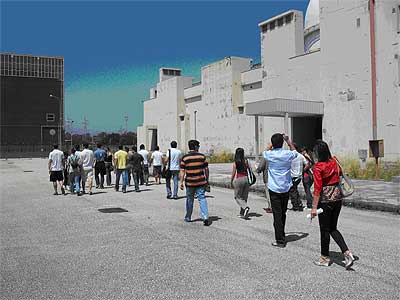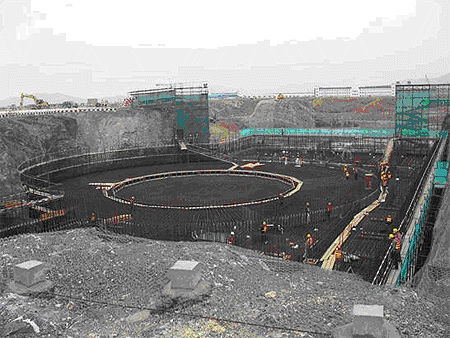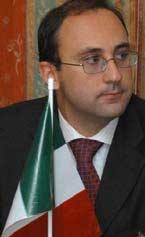
European
Nuclear Society
e-news
Issue 24 Spring 2009
http://www.euronuclear.org/e-news/e-news-24/italy.htm

One of the objectives of the ENS Young Generation Network is the exchange of knowledge between the older and younger generation. In Italy there is a big generation gap between these two generations, largely due to more than 20 years of nuclear phase-out policy. The actual Italian Young Generation is very motivated and ready to affirm that it is not true that all the national technical background in the nuclear field is completely lost. This paper analyses the past and present nuclear situation in Italy with a focus on the industrial sector that is still lively with Ansaldo Nucleare, a company that has been working mainly abroad in these 20 years and that recently hired a number of young professionals. Ansaldo Nucleare, a subsidiary of FINMECCANICA Group company Ansaldo Energia, is today very well placed in the highly competitive international nuclear market and it can lead industrial companies to a significant contribution to Nuclear Power Plant construction in Italy as well as abroad in the next future. Ansaldo had an important role also in the past due to a strong industrial background.
The Italian scientist Enrico Fermi was a pioneer for the development of nuclear energy leading to the first artificial, self-sustaining, nuclear chain reaction (Chicago Pile-1) initiated on December 2, 1942.
After the Second World War, Italy started an ambitious program of construction of Nuclear Power Plants (NPPs), facilities and research reactors reaching a high level of expertise. In 1965 Italy ranked third for nuclear installed capacity after USA and UK.
In 1958 the construction of the first civil British Magnox reactor started in Latina. The following year construction of the first General Electric boiling water reactor commenced for Garigliano NPP. In 1961, the first Westinghouse pressurized water reactor was built for Trino Vercellese Site. The 860 MWe Caorso NPP started commercial operation in 1978.
In Italy 4 Nuclear Power Plants were operating between 1963 and 1987 and Ansaldo Nucleare contribution was substantial.
In 1972 Ansaldo started to build a 40 MWe prototype reactor, with heavy water moderation and light water cooling, called CIRENE, that was finished, tested, but never operated.
In 1973 ENEL took a 33% share of the Super Phenix 1,200 MW fast neutron breeder reactor being built at Creys-Malville in France as a French-Italian-German joint venture. The plant was closed in 1998. Ansaldo role on the commissioning was relevant and today Ansaldo personel are still working at Creys-Malville for the decommissioning of the plant.

Figure 1: YG visit to Latina NPP and CIRENE NPP for University students
Following a referendum in November 1987, after the Chernobyl accident, the Italian nuclear program was suddenly stopped as a unique worldwide case. The phase out involved the operating plants, two new almost complete nuclear BWR plants (Montalto di Castro 1 & 2) and the PUN (Progetto Unificato Nucleare) reference design for the construction of six PWRs plants. ENEA (formerly CNEN) also closed various fuel cycle facilities, including a fuel fabrication plant at Bosco Marengo.
In 1989 Ansaldo Nucleare became an independent company within the FINMECCANICA group gathering the experts coming from the two companies Ansaldo Impianti SpA and NIRA SpA (Nucleare Italiana Reattori Avanzati).
Ansaldo Impianti SpA (1986) was previously called AMN SpA (Ansaldo Meccanico Nucleare); AMN was created in 1963 within IRI/FINMECCANICA group for National and International nuclear activities.
NIRA (1972) was involved in advanced reactor projects such as Superphenix-FBR, Cirene- BHWR, PEC-Italian Prototype of FBR.
In 1999 Ansaldo Nucleare became a Division of Ansaldo Energia SpA a company within the FINMECCANICA group.
In 2005 Ansaldo Nucleare SpA became a FINMECCANICA company controlled by Ansaldo Energia SpA.
Inspite of its previously high level ofactivity and expertise, Italy remained largely inactive in nuclear energy within the country while working very actively in foreign countries.
In 1999 SOGIN (Societa Gestione Impianti Nucleari) was set up as a state-owned enterprise to take over all Enel's and ENEA's nuclear assets. It was set to take responsibility for all nuclear wastes and for the decommissioning of all NPPs and Facilities. Ansaldo Nucleare provided support for these important and demanding tasks in the country.

Figure 2: Actual logo of Ansaldo Nucleare SpA
www.ansaldonucleare.it
Ansaldo Nucleare has mainly operated abroad in the past twenty years, achieving significant successes.
An example of such a success is the construction of the two units Cernavoda 1 & 2 in Romania a world class performing NPP built in partnership with the Canadian AECL (Atomic Energy of Canada Ltd.). The owner and operator is the Romanian nuclear state utility SNN (Societatea Nationala Nuclearelectrica). Canada’s CANDU (CANada Deuterium Uranium) technology has contributed to Romania’s healthy nuclear industry, and has proven to be an important economic asset for the country. Nuclear power now accounts for about 20 per cent of Romania’s energy supply and significantly reduces its dependency on other energy resources from outside of Europe.
Ansaldo Nucleare has also made a substantial contribution to the development of passive plant technology, as licensee and partner to US company Westinghouse Electric Company, now a group company of Toshiba Corporation.
It contributed to the design of new concept passive systems and main plant components that led to obtaining Design Certification for the AP600 system and later also for the AP1000.
The AP1000 is the only Generation III+ Advanced Light Water Reactor with improved economics and safety aspects to receive Design Certification from the U.S. Nuclear Regulatory Commission (NRC).
Having received Design Certification, the AP1000 has the highest degree of design completion and its readiness for implementation; for this reason several U.S. utilities have selected the AP1000 design in their applications to the U.S. NRC for combined construction and operating licenses. Among the four AP1000s under construction in China the first unit is scheduled to be online by November 2013. Ansaldo Nucleare in a joint venture with Mangiarotti Nuclear signed an important contract with Westinghouse Electric Co. to design and supply innovative components for the first unit of the new generation power plant to be built at the Sanmen site.

Figure 3: construction of the first AP1000 at Sanmen NPP site in China
Today, Italy is the only G8 country without operating nuclear reactors. Instead, it relies upon imports of nuclear electricity from its neighbours. Italy, which has a few domestic energy resources, is the world's largest electricity importer. Electricity prices are therefore higher than the European average and the country is heavily dependent upon oil, gas and on imports.
In Italy there is an increasing political and public support for nuclear energy confirming the wind of “nuclear renaissance”, that is evident in the entire world. After more than 20 years, the actual new third generation of advanced nuclear power plants is considered important to generate electricity that is safe, plentiful, economical and clean from greenhouse gases. An increasing part of the population now believe that nuclear energy can be beneficial to achieve security of supply with a new and diverse energy mix.
The actual Italian government is interested to start building new nuclear power plants, to reduce the country's great dependence on oil, gas and imported power. It will work towards having 25% of its electricity from nuclear power by 2030, which will require 8 to 10 large new reactors by then. The government introduced a package of nuclear legislation, better suited for possible new nuclear constructions.
A public opinion poll in July 2008 found that 54% supported nuclear power in Italy while 36% opposed it; 83% were opposed to Italy building new nuclear power plants for itself in neighbouring countries, while 11% thought it was a good idea.
Electrical utilities companies operating in Italy are demonstrating their nuclear expertise abroad. The first Italian utility company ENEL is the majority owner of Slovakian utility Slovenske Elektrarne (SE) with five operational commercial reactor units, two Shut down and two Under Construction units. ENEL is involved in the project to complete construction of units three and four of Slovakia’s Mochovce nuclear power plant before 2012. Ansaldo Nucleare provides support for some of the activities connected to the completion of Mochovce 3 & 4.
ENEL is present in France, with the construction, together with EDF, of the EPR in Flamanville. ENEL is present in Spain with Endesa in the operation of 7 Nuclear Power Plants. Other utility companies are very interested in new investments in Italy.
The majority of Italian companies that were active in the early ’80s abandoned the sector long ago. Among the big Groups that kept working in the nuclear field until now only Ansaldo and Techint remain. Ansaldo Nucleare S.p.A. is a subsidiary of FINMECCANICA Group company Ansaldo Energia S.p.A., a major world player in the construction of NPPs. Today, it is in charge of the nuclear sector, with its mission to promote and carry-out ther following:
new nuclear power plants projects,
service activities to operating nuclear plants,
waste treatment and decommissioning of nuclear plants and facilities.
Ansaldo Nucleare is also involved in a number of international R&D (Research and Development) projects on new reactor systems. These include Euratom projects, the IRIS (International Reactor Innovative and Secure) Generation III+ Reactor, a Generation IV design called ELSY (European Lead-cooled System), the EFIT (European Facility for Industrial Transmutation) sub-critical 400 MWth reactor cooled by liquid lead and driven by a proton accelerator.
Within the TECHINT group of engineering and construction companies specialised in large infrastructure, industrial and civil projects there is an Italian subsidiary working in the nuclear field. Outside these two big groups, there are also other companies active in the sector, including:
Mangiarotti Nuclear,
Thales Alenia Spazio and CESI (Centro Elettrotecnico Sperimentale Italiano),
SRS (Servizi di Ricerche e Sviluppo),
IBF
SOGIN (SOcieta Gestione Impianti Nucleari, a state-owned enterprise that can be an industrial partner).
These companies can be the base for a much wider involvement that can be beneficial for the entire Italian industrial system.
According to a recent evaluation, Italian companies can contribute, in the near future, to 75% of a Nuclear Power Plant (NPP) construction.
It is therefore essential to start investing now in human resources and equipment, in order to compete abroad and be ready for the national market.
Nuclear energy is beneficial as an important energy source and for an overall economical and technological growth. Nuclear technology is still relatively young and it has a large potential for improvements and breakthroughs for power and non-power applications: for this reason it cannot be abandoned as our country seems to have done in the past 20 years. A reconsideration of the nuclear option to provide a more balanced energy mix and to decrease the energy dependence from abroad is today a reality in Italy.
An increasing number of young professionals have been hired especially in the industrial sector; Ansaldo Nucleare company has the potential to lead other companies to a significant contribution to Nuclear Power Plant construction in Italy as well as abroad in the next future.
WNA 2009, Nuclear Power in Italy.
IAEA 2003, Country Nuclear Power Profiles
FINMECCANICA Magazine (December 2008)
Power Generation News; Ansaldo Energia publications (January & March 2008)
Westinghouse Electric Co.; AP1000 publications (2008)
Terrani P., Adinolfi R.; Le Capacita’ Produttive Nazionali; Giornata di Studio AIN (November 2008).
Mainardi E.: Impieghi dell'energia nucleare, Delfino Editor (January 2008)
 |
Enrico MAINARDI is a Senior Engineer at Ansaldo Nucleare, a Finmeccanica Company. He is Chairman of the Italian Young Generation Network, involved in the work of the IYNC (International Youth Nuclear Congress) and in the ENS YGN (Young Generation Network) Core Group. He has gained considerable experience as the Deputy Secretary General of AIN (the Italian Nuclear Association) and has written a book on nuclear energy [ref.7 www.enricomainardi.it/book.html ]. He has a degree in Nuclear Engineering from the University of Bologna, a PhD in Energetics from the University of Rome "La Sapienza". He has gained experience in several areas of energy and nuclear science and technology in USA, Europe and Eastern countries. |

![]()
© European Nuclear Society, 2009